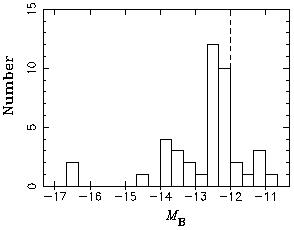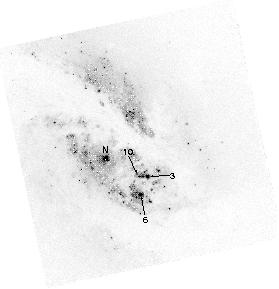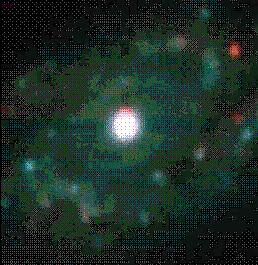


4.6. Compact Super Star Clusters, Compact Radio Sources and Radio Supernovae
One of the most exciting achievements brought by the high angular
resolution of the HST is the discovery of extremely compact and
luminous objects, judged to be young globular clusters. They have been
found in dwarf galaxies, interacting/merging galaxies, starburst
galaxies and the central galaxy in the Perseus cluster NGC 1275 (for
references see
Holzman et al. 1996).
They have been found in nuclear
rings in at least eight barred galaxies
(Benedict et al. 1993;
Barth et al. 1995;
Maoz et al. 1996).
Whitmore and Schweizer
(1995)
found more than 700 such clusters in the strongly interacting pair of
galaxies called `The Antennae'. Their luminosities may reach
MV  -14 and
they are often called `super star clusters' (SSCs).
-14 and
they are often called `super star clusters' (SSCs).
Spectra of bright compact blue objects obtained in NGC 1275 by Zepf et al. (1995) and in NGC 7252 by Schweizer and Seitzer (1993) show strong Balmer absorption lines similar to that of a late A- to a middle F-type star. All evidence taken together suggests that these compact objects are young globular clusters. A young globular cluster with an age of 107 years would over 1010 years fade some 7 magnitudes to a similar brightness as the globular clusters in the Galaxy. However, they may not all be young. From photometry of 120 SSCs in the compact blue galaxy ESO338-IG04 Östlin et al. (1998) find a wide spread in ages from a few Myr to ~ 10 Gyr and indications that the star forming history is marked by short bursts.
In order to get a clearer picture of the nature of the hot spots and their relation to the circumnuclear radio sources Kristen et al. (1997) imaged the nuclear region of NGC 1365 with the HST. The pre-refurbishment HST/FOC in the F/96 mode gave a field that mainly covered the nucleus and the two major hot spots L 2 and L 3 (Fig. 16). The HST/FOC resolved the star forming regions and the whole circumnuclear region into a large number of bright, very compact SSCs that together seem to form part of a ring around the nucleus. Their radii, as judged from the pre-refurbishment HST images, seem to be only a few pc.
Fig. 27 shows the distribution of absolute magnitudes for 42 of these sources, assuming an extinction of 2m.5 in the B magnitude (see the discussion in Section 4.1). Considering that the brightest globular clusters in the Galaxy have absolute visual magnitudes of ~ -10m we see that there are no nearly similar objects known in the Milky Way.

|
Figure 27. Distribution of absolute magnitudes for the SSCs around the nucleus of NGC 1365. The vertical dashed line indicates the completeness limit for detections. From Kristen et al. (1997). |
As seems to be the case in other galaxies, many of the clusters form in tight groups, with a single giant H II region containing typically a dozen clusters. The two brightest SSCs in the region, SSC:3 and SSC:6, coincide in position with the intensity maxima of the hot spots L 2 and L 3, respectively. As seen in Fig. 27 they are more than two magnitudes brighter than the rest. If belonging to NGC 1365 their absolute magnitudes, even in the case of no extinction, would be -14m.1. At present, it can not be entirely excluded that they are foreground stars.
According to a published abstract Griffiths et al. (1997), with the Wide Field Planetary Camera 2 (WFPC2) on the HST, have extended the discovery of these objects in NGC 1365 to the entire nuclear region. In Fig. 28 we reproduce one of these WFPC2 frames from the HST Archive. The pixel size is 0".10 (9 pc) square, and the filter used is a wide band V filter (F555W) with an average wavelength 5252 Å.

|
Figure 28. The central region of NGC 1365 seen with the HST/WFPC2 through a wide band V filter. The nucleus (N) and compact super star clusters number 3, 6, and 10 are indicated. The distance between clusters 3 and 6 is 2".71. From the HST Archive (PI John Trauger). |
As can be seen from this figure, the SSCs form a ring around the nucleus inside the two dust lanes that come in from the front side of the bar. However they reappear, as remarked by Griffiths et al., on the outer side of these dust lanes out to at least some 20" from the nucleus. Noteworthy is the empty zone around the nucleus with a sharp border at a radius of 2".5. There is a possibility that this border is related to the Inner ILR (Section 4.5).
Of the three bright compact circumnuclear radio sources named A, D and G, suggested by Sandqvist et al. (1995) to be radio supernovae, detected at 2 cm and still unresolved at a resolution of 0".25 x 0".10 (Section 4.4), source A falls in the field of the HST/FOC. The spatial resolutions of the HST frame and of the VLA at 2 cm are very nearly the same. According to Kristen et al. (1997) this radio source coincides within the error of the positions with the SSC:10 (Fig. 28). The exact superposition of the SSC and the radio source depends on the accuracy of the coordinate scales obtainable with the HST/FOC and the radio offsets of the radio source from the nucleus. The radio position of the nucleus could be measured only at 6 cm wavelength, i.e. with less accuracy than the compact radio sources themselves. Thus, the exact coincidence of SSC:10 and the compact radio source A should be confirmed.
Of the two other compact radio sources, D falls in a tight group of SSCs positioned in the prominent dark dust lane just north of the nucleus, while source G lies in the middle of this dust lane where no object is seen in the WFPC2 V-band.
However, an image of the nuclear region of NGC 1365, obtained with the cryogenic infrared spectrometer and array camera (ISAAC) on the UT1 of the VLT, has been published by Moorwood et al. (1998). This image, reproduced in Fig. 29, is a combination of frames obtained in the Ks(2.16 µm) and L(3.8 µm) bands. A large number of star forming regions are well resolved. As it turns out, two of the brightest and as well the two reddest of these regions, that appear within the dust lane north of the nucleus and close to the upper edge of the frame, coincide with the compact radio sources G and D, G being the brighter in the infrared. In contrast, the radio source A cannot be seen in this image. The source of the infrared radiation may be dust heated by the radio sources.

|
Figure 29. Combination of Ks- and L-band images of the central region of NGC 1365 obtained with the ISAAC camera on the Unit Telescope 1 of the ESO VLT. The field is 16".4 x 17".1. The two very red objects close to the northern edge coincide with the two compact radio sources D and G. From Moorwood et al. (1998). |
The connection between young globular clusters, compact radio sources, possible radio supernovae and infrared sources is intriguing and should bear important information on the nature of these strange kinds of objects.